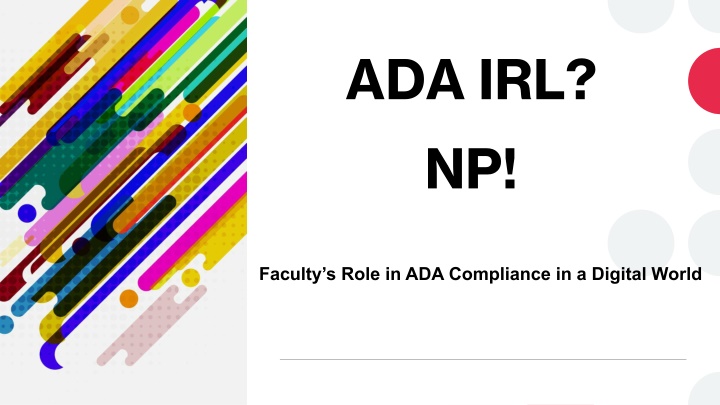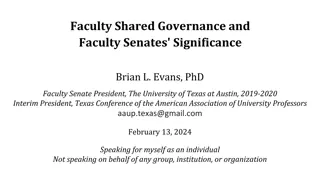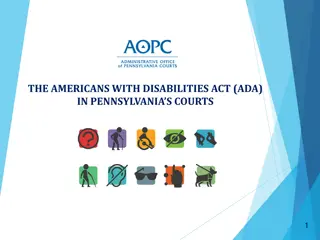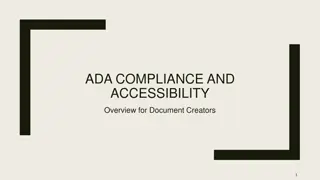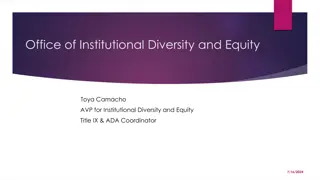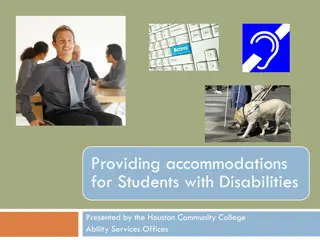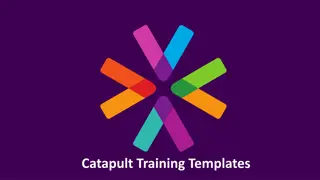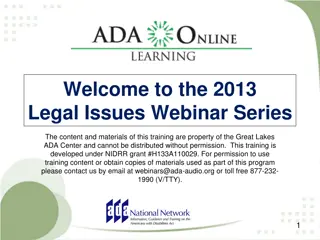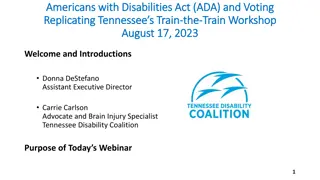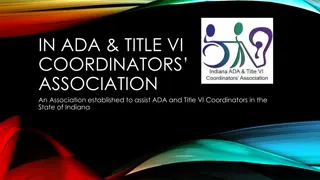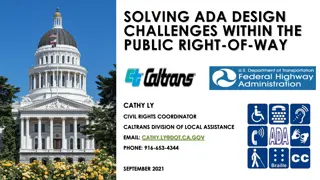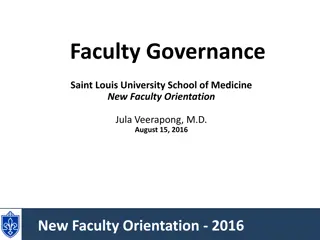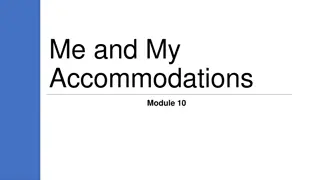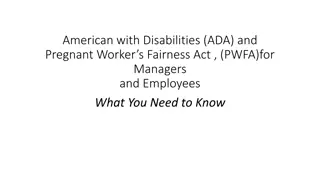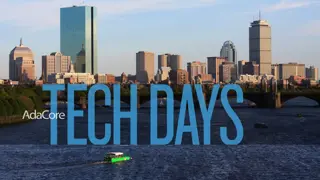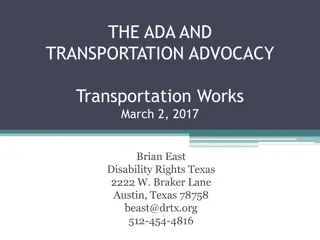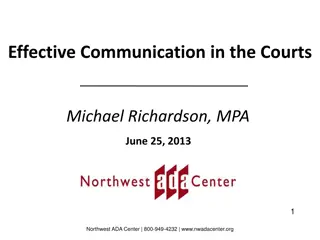Faculty's Role in ADA Compliance in a Digital World
Legal obligations under ADA Title II & Section 504 for state and local governments to ensure equal communication and access for individuals with disabilities in digital spaces. Examples and risks associated with non-compliance.
Download Presentation

Please find below an Image/Link to download the presentation.
The content on the website is provided AS IS for your information and personal use only. It may not be sold, licensed, or shared on other websites without obtaining consent from the author.If you encounter any issues during the download, it is possible that the publisher has removed the file from their server.
You are allowed to download the files provided on this website for personal or commercial use, subject to the condition that they are used lawfully. All files are the property of their respective owners.
The content on the website is provided AS IS for your information and personal use only. It may not be sold, licensed, or shared on other websites without obtaining consent from the author.
E N D
Presentation Transcript
ADA IRL? NP! Faculty s Role in ADA Compliance in a Digital World
Legal Obligations ADA Title II & Section 504 ADA Title 2 State and Local Government Entities Section 504 Recipients of Federal Financial Assistance Standard Equally Effective Communication Also Reasonable Modification of Policies, Practices and Procedures Also Not Excluding, Denying Equal Benefit, Denying Equally Effective Benefit, Requiring Separate Service, Segregation Also Eligibility Criteria or Methods of Administration that Screen Out or Tend to Screen Out
Legal Obligations ADA Title II & Section 504 Latest statement from DOJ on web accessibility https://beta.ada.gov/resources/web-guidance/ Title II of the ADA prohibits discrimination against people with disabilities in all services, programs, and activities of state and local governments. State and local governments must take steps to ensure that their communications with people with disabilities are as effective as their communications with others.
https://beta.ada.gov/resources/web-guidance/ Web Accessibility for People with Disabilities is a Priority for the Department of Justice Examples Miami University in Ohio: The Department reached an agreement with the university to resolve the US lawsuit alleging the school discriminated against students with disabilities by providing inaccessible web content and learning management systems. Louisiana Tech: The Department reached an agreement with Louisiana Tech University to address claims that the university violated the ADA by using an online learning product that was inaccessible to a blind student.
Legal Risks - Government Department of Justice Damages, Injunctive Relief (monitoring & reporting), Court oversight, Civil penalties Title II regulation addressing web accessibility next year Standard (WCAG 2.0/2.1 A & AA) Currently one way of complying if you can find another standard that provides equally effective communication, you may use it Universities already covered so lack of regulation is no excuse Department of Education Office for Civil Rights is undertaking investigations and compliance reviews of inaccessible educational technology and websites Applying WCAG 2.0/2.1 A & AA Damages, Injunctive Relief (monitoring & reporting), Funding withdrawal 2010 Dear Colleague Letter must not require use of technology that is not accessible unless you give students with disabilities the same experience
Legal Risks - Private Injunctive relief Damages Attorneys fees Court oversight Reputational harm
Accessibility Isnt Limited to Websites Digital Technology & Digital Information Registration and other online forms Reading materials for classes Videos Learning games Collaborative learning tools Virtual classrooms and office hours Learning management systems Digital examination systems Clickers and polls Self-service kiosks Social networking Augmented reality Virtual reality Digital research platforms and materials AI-powered teaching assistants Adaptive course delivery
Faculty Roles in Digital Technology and Information Selector faculty select types of technology and digital information (e.g. websites, videos, digital materials) to use in their classes and to require students to use (sometimes from university-approved options; sometimes without university input or even knowledge) Creator faculty develop digital documents, videos, and other digital content, and make them available, either on technology platforms (purchased or free; university-approved or not) or via email or in class
Faculty Roles in Digital Technology and Information User faculty use the technologies and digital information they create or select and the technologies and digital information their universities or vendors select or provide Facilitator faculty require students to use technology and digital information (including when, where, and how it will be used), facilitate student access to the technology and information, and approve or offer exceptions, alternatives, or work-arounds to technology and digital information
Faculty Accessibility Responsibility & Resources Selector Responsibility Ensure technology & content are accessible
Selector Resources Policy requiring selection of accessible technology (including digital materials) making faculty responsible University policy on procurement of accessible technology Must include free and click-to-agree technology Must define accessibility (WCAG 2.0/2.1 Level A & AA) Accommodation is not an acceptable alternative
Selector Resources Contract language Standard (WCAG 2.0/2.1 A & AA) Standard for what vendors must provide to demonstrate accessibility (VPAT, certification, test results, opportunity to test) If accessible technology unavailable, require ongoing improvement Accountability/indemnification
Selector Resources Accessibility experts to assess vendor statements and test accessibility Process and timelines for faculty submission of proposed tech for testing in advance Process for approving exceptions and alternative means of access Only when undue burden, fundamental alteration or unavailability Documentation Advance development of equally affective alternative means of access
Selector Resources List of approved accessible technologies and vendors Funding if accessible tech is more expensive than inaccessible Training on what accessibility means and why it is important Process for faculty certification of accessibility Periodic accessibility audits and accountability Feedback mechanism
Faculty Accessibility Responsibility & Resources Creator Responsibility Make the technology & content accessible
Creator Resources Policy requiring creation of accessible technology and content (and making faculty responsible) Advance submission and approval of technology/ content for testing and setting timelines Faculty certification of accessibility if not tested Process for approving exceptions and alternative means of access Only when undue burden or fundamental alteration Documentation Advance development of equally affective alternative means of access
Creator Resources Training What accessibility means And what it is not (e.g., scanned PDFs; automated captions) How to achieve it Especially common formats (Word, PDF, video, html, ppt) How to test it Internal experts To assist with making tech and content accessible To test accessibility
Creator Resources Approved and contracted accessibility service contractors E.g. captioning provider PDF remediator Funding For external accessibility experts or services Accessibility checkpoints before posting on university platforms (web, LMS, social media) Periodic accessibility audits and accountability Feedback mechanism
Faculty Accessibility Responsibility & Resources User Responsibility Use technology and content in an accessible manner
User Resources Policy Requiring use of technology with accessibility features (e.g., captions) activated as default Requiring timely implementation of equally effective alternative access, developed in advance, for any inaccessible technology Training On the accessibility features of any University-provided technology On equally effective alternative access in general On equally effective alternative access developed for particular inaccessible technologies in use
User Resources Expertise Assistance to faculty on implementation of accessible features Assistance on timely implementing equally effective alternative access for any inaccessible technology Periodic audits of implementation of accessibility features and equally effective alternative access plans Feedback Mechanism On effectiveness of accessibility features On equally effective alternative access plans
Faculty Accessibility Responsibility & Resources Facilitator Responsibility Explain how, and assist students, to use the technology and content in an accessible manner
Facilitator Resources Policy Requiring faculty to know how to explain accessibility features Requiring faculty to know how to connect students to expertise Requiring faculty to timely implement equally effective alternative access Process for students to seek accessibility or equally effective alternative access (not from faculty) Approval and funding provided by University experts Faculty informed and required to implement (anonymous) accessibility features or equally effective alternative access Process for faculty to argue against accessibility, but not veto power
Facilitator Resources Feedback Mechanism On effectiveness of facilitation of activation of accessibility features On effectiveness of implementation of equally effective alternative access plans
Eve Hill Brown Goldstein & Levy, LLP www.browngold.com Inclusivity Strategic Consulting www.inclusivity.consulting 120 E. Baltimore St., Suite 2500 Baltimore, MD 21202 ehill@browngold.com (410) 962-1030, ext. 1311
